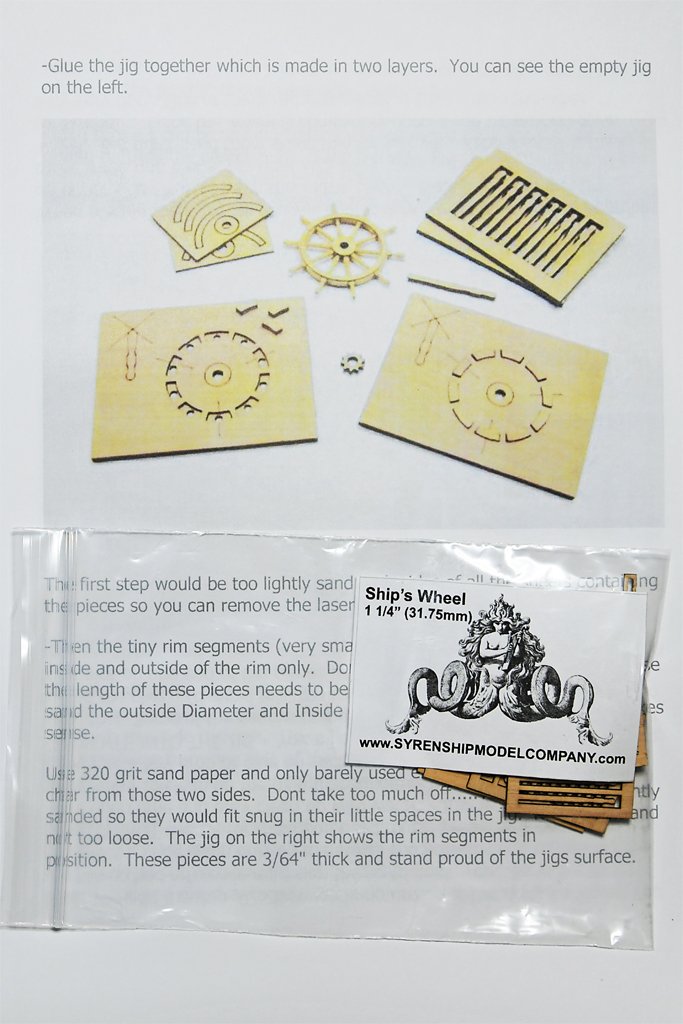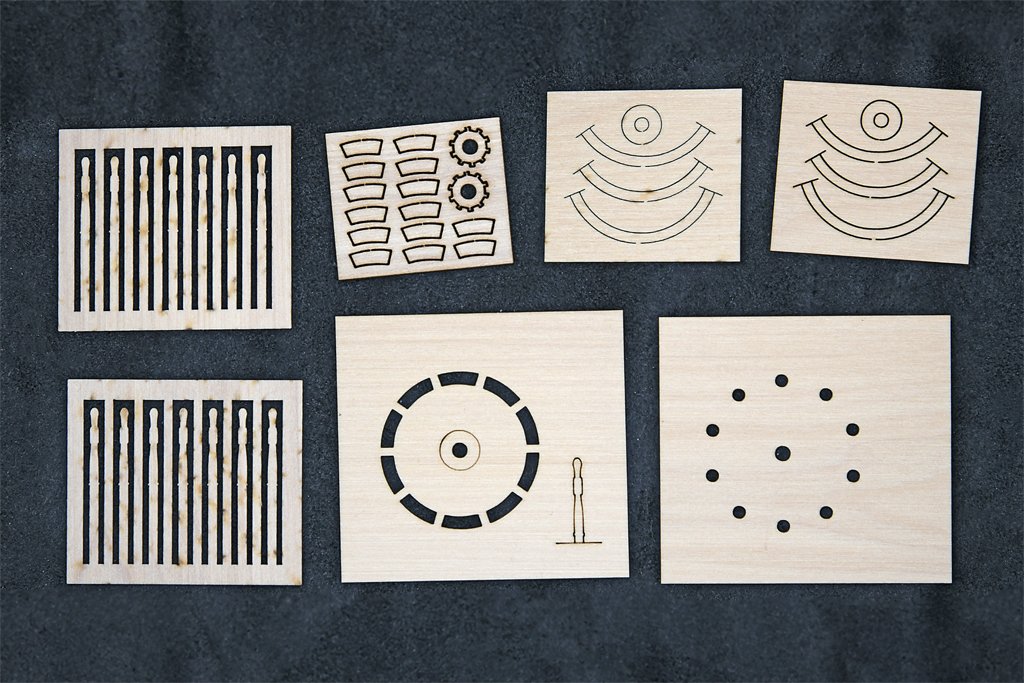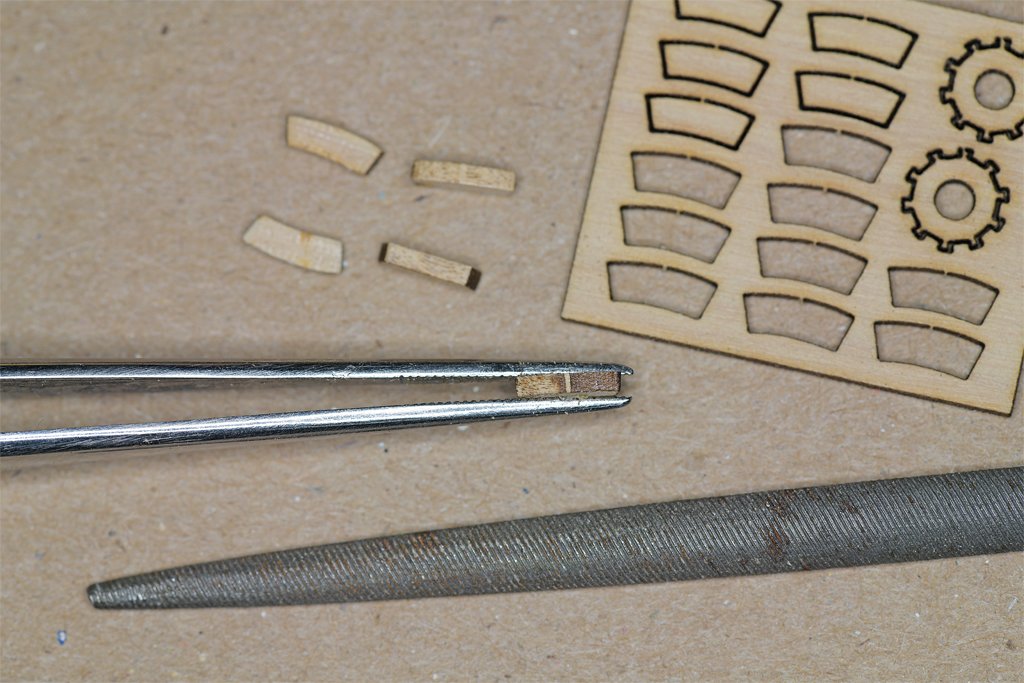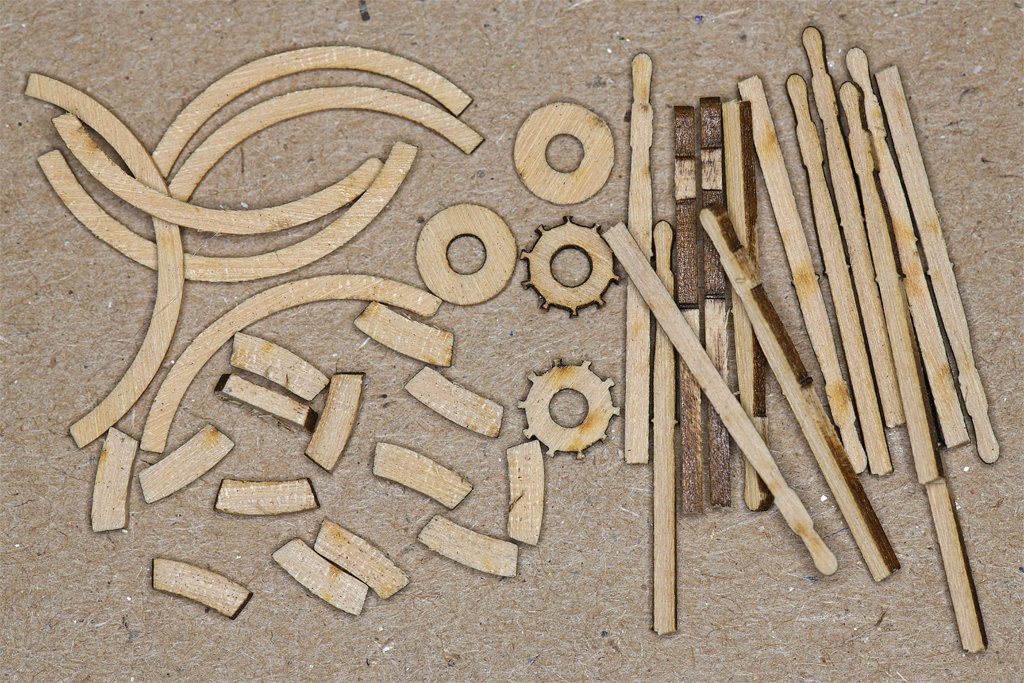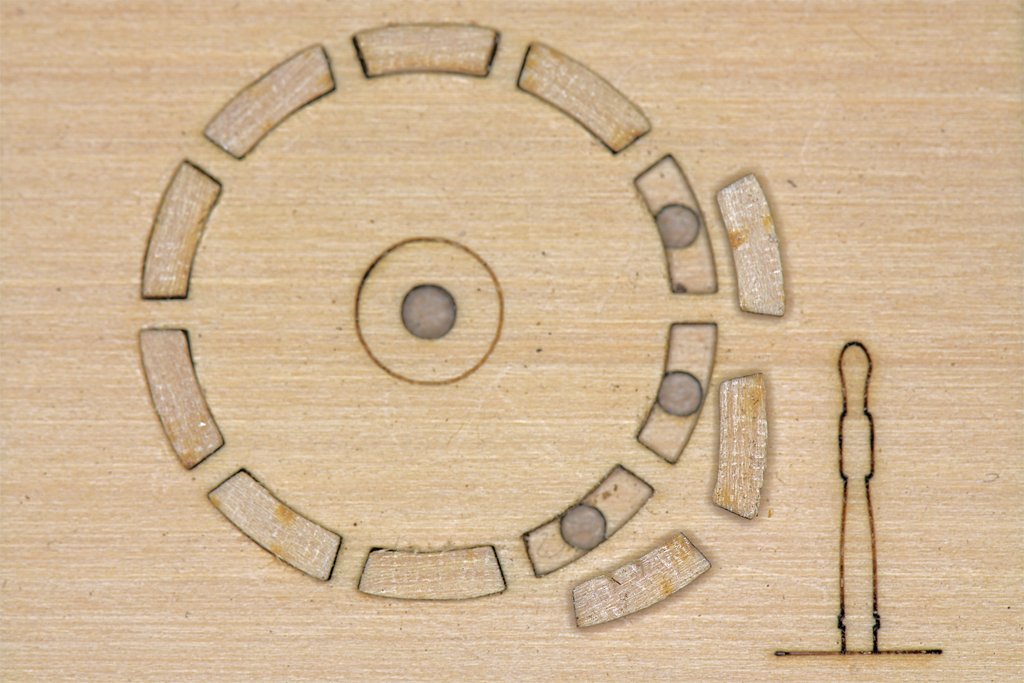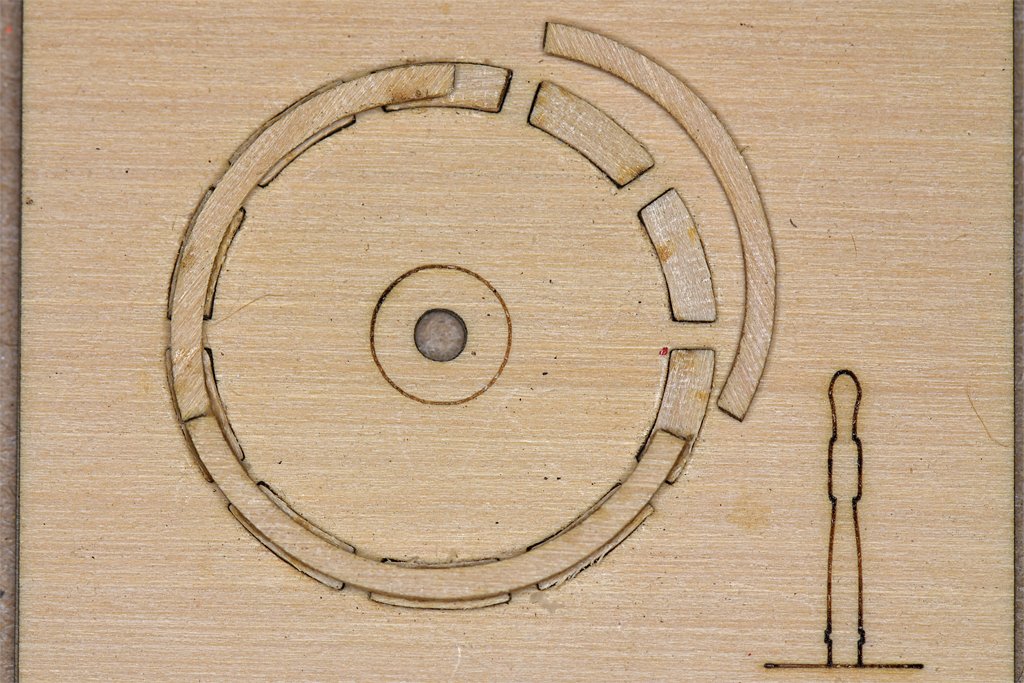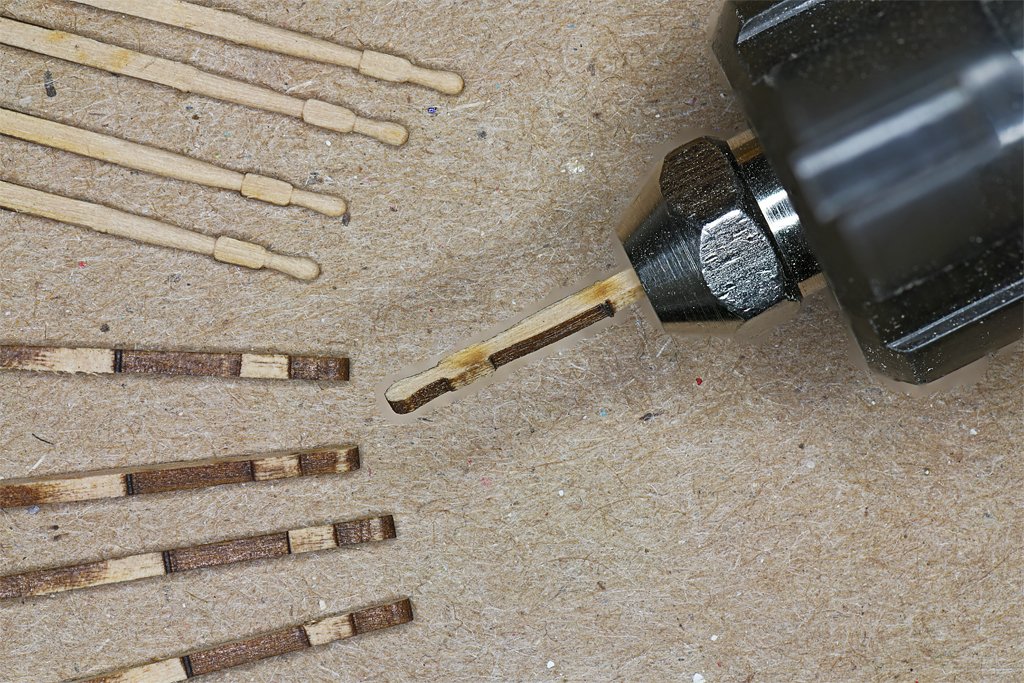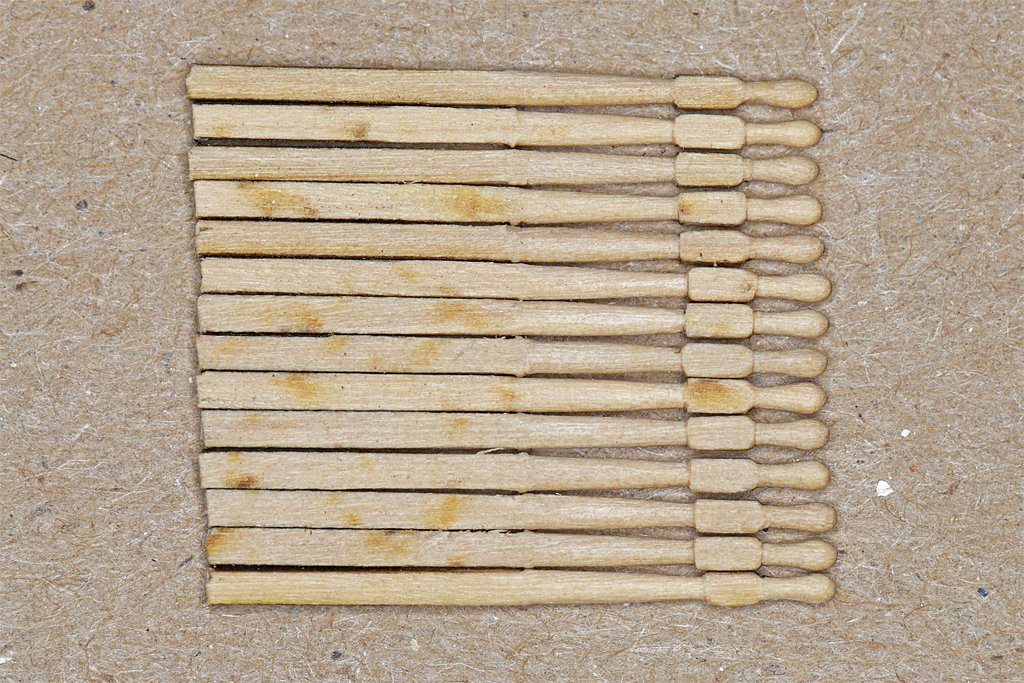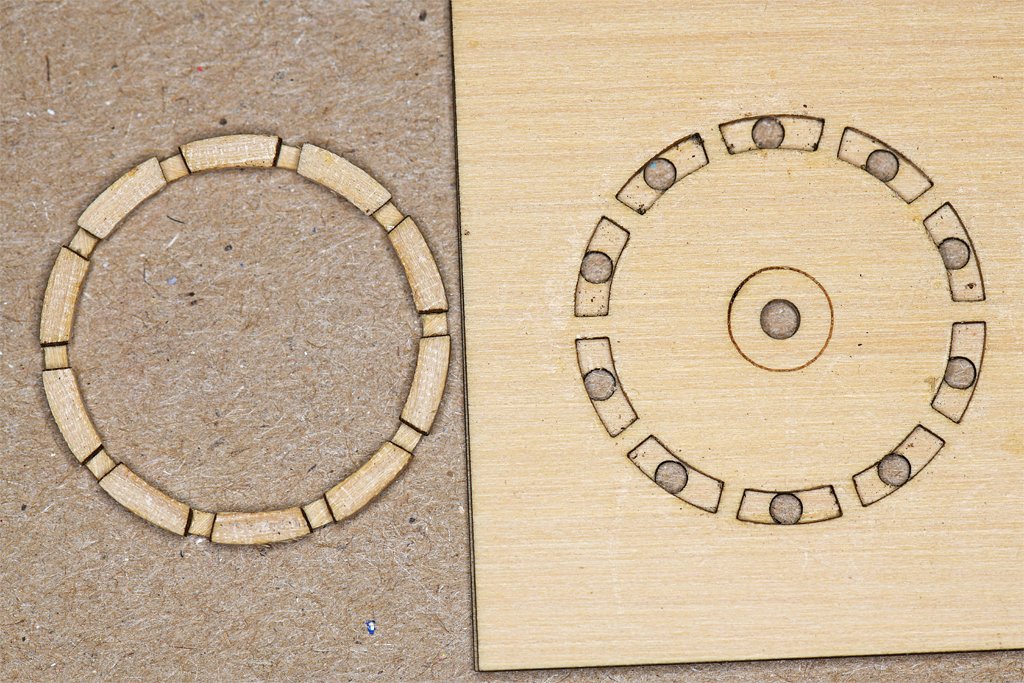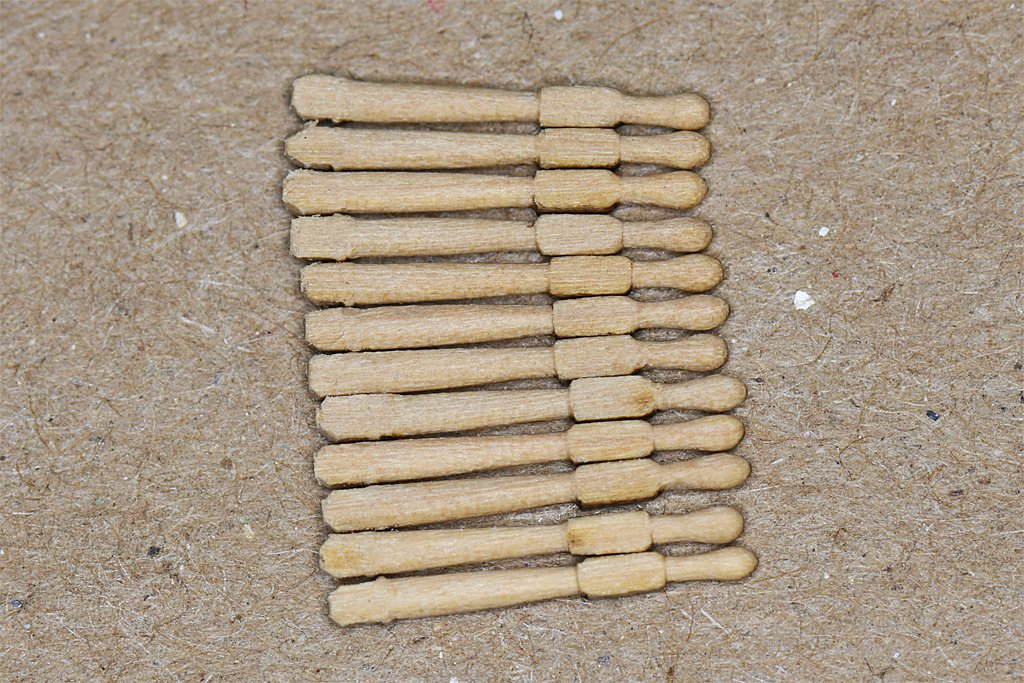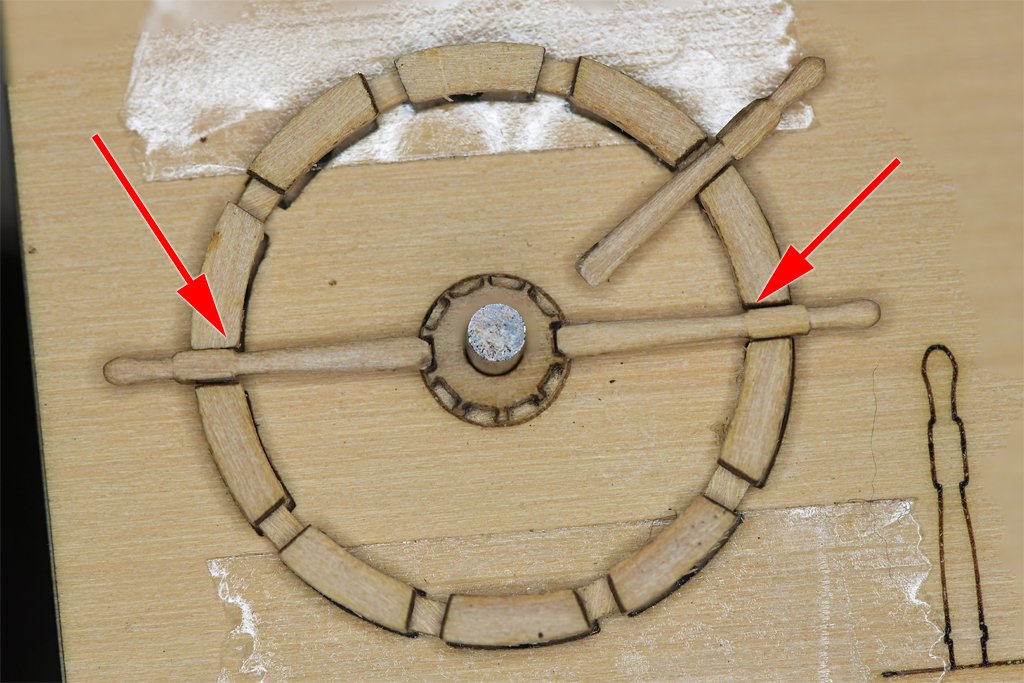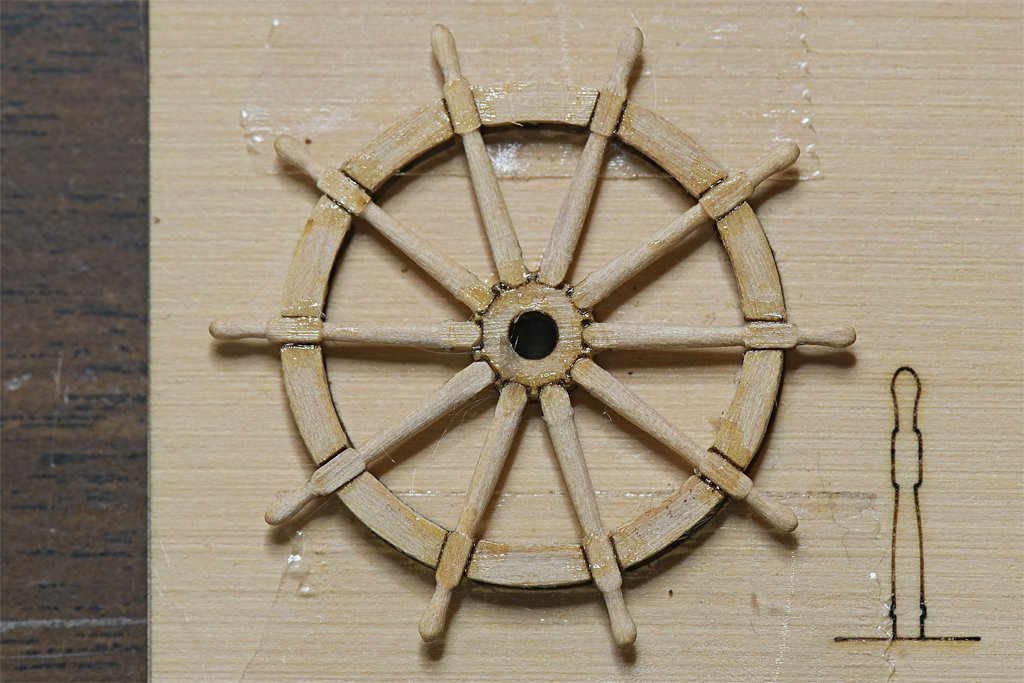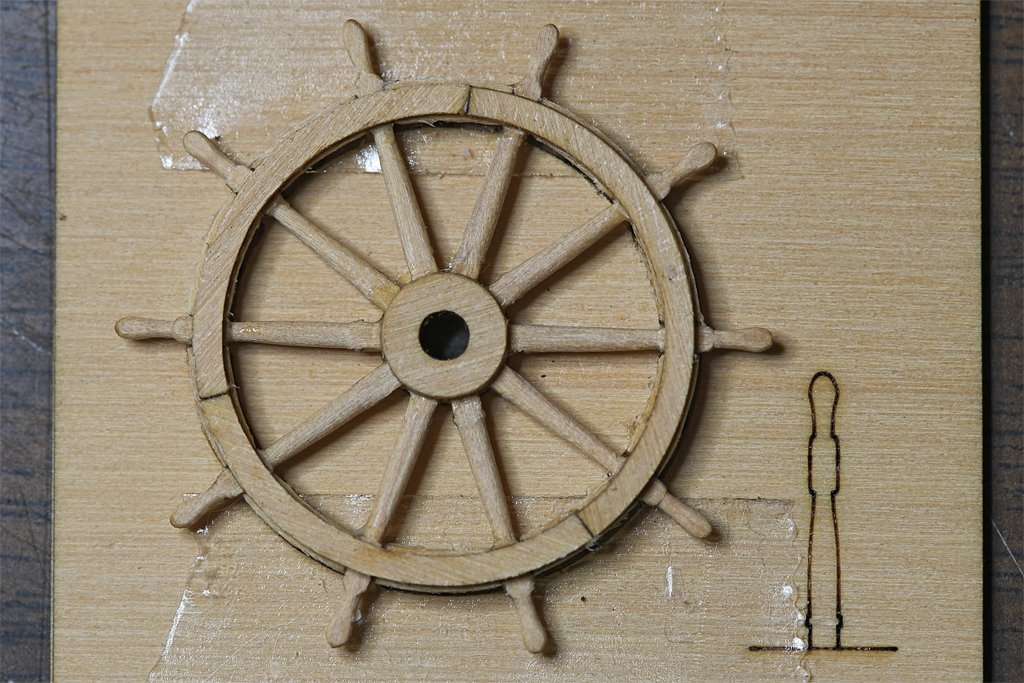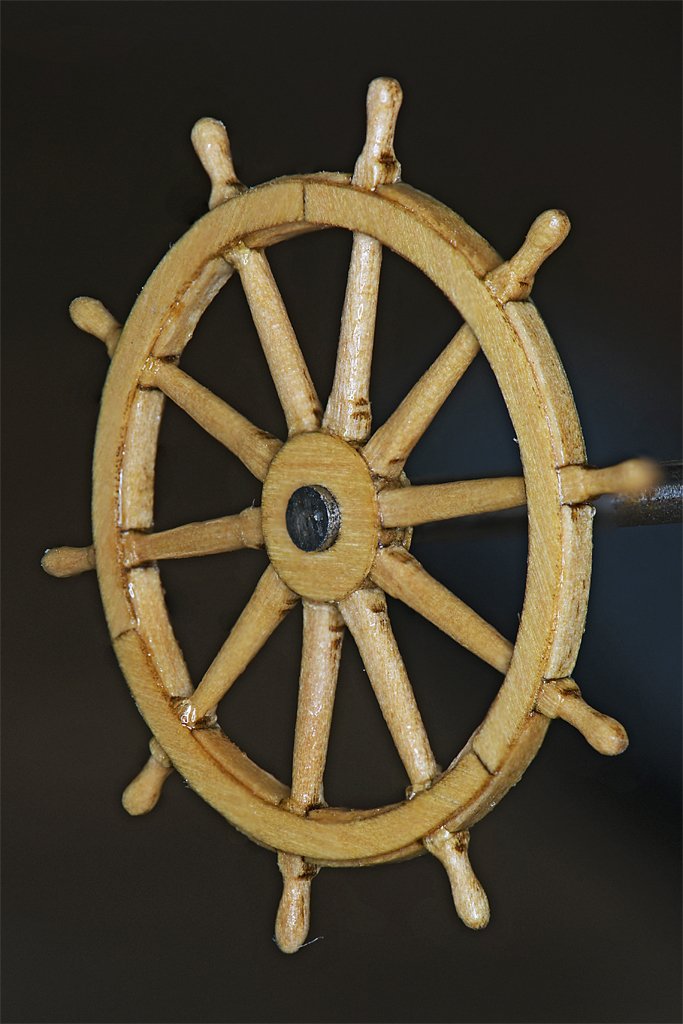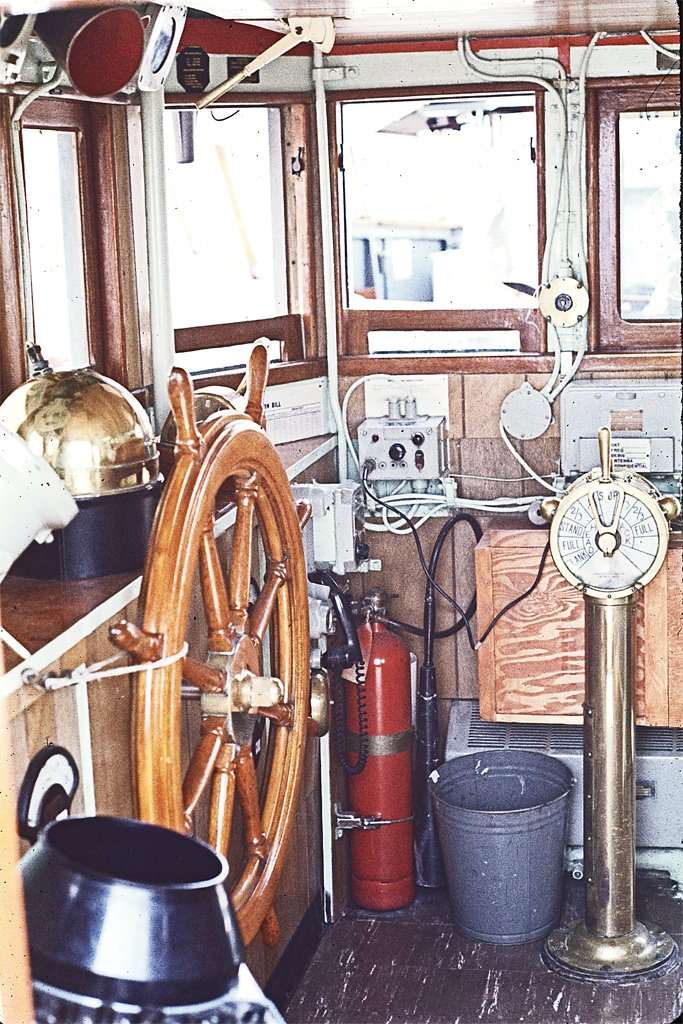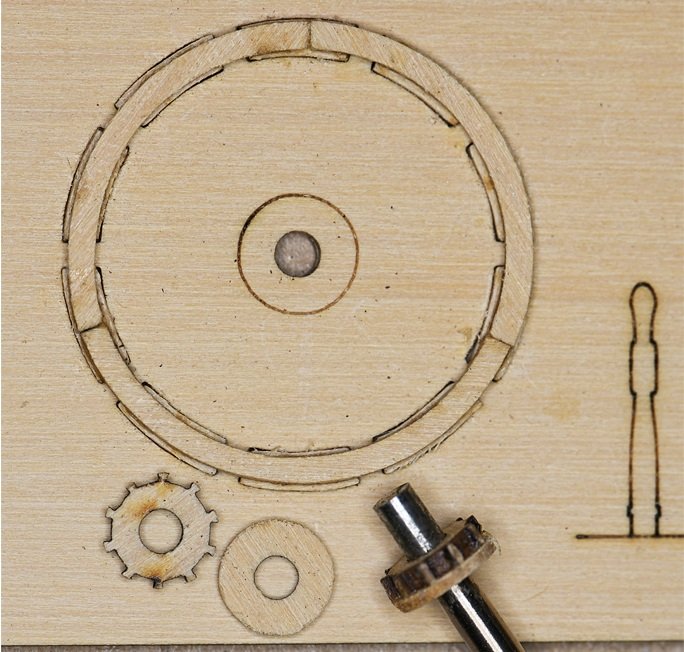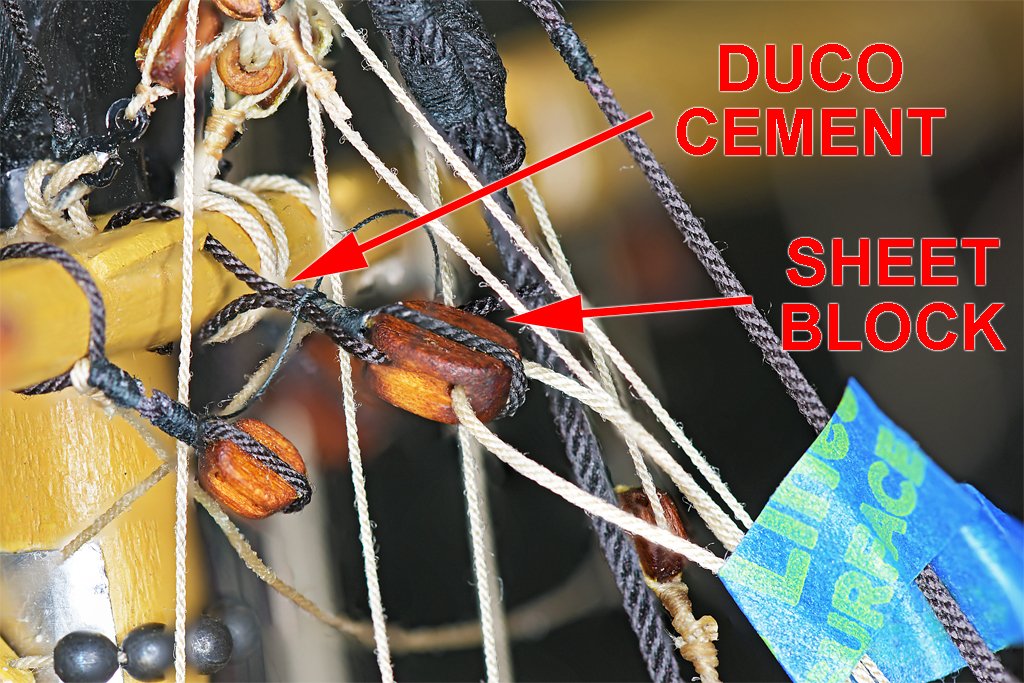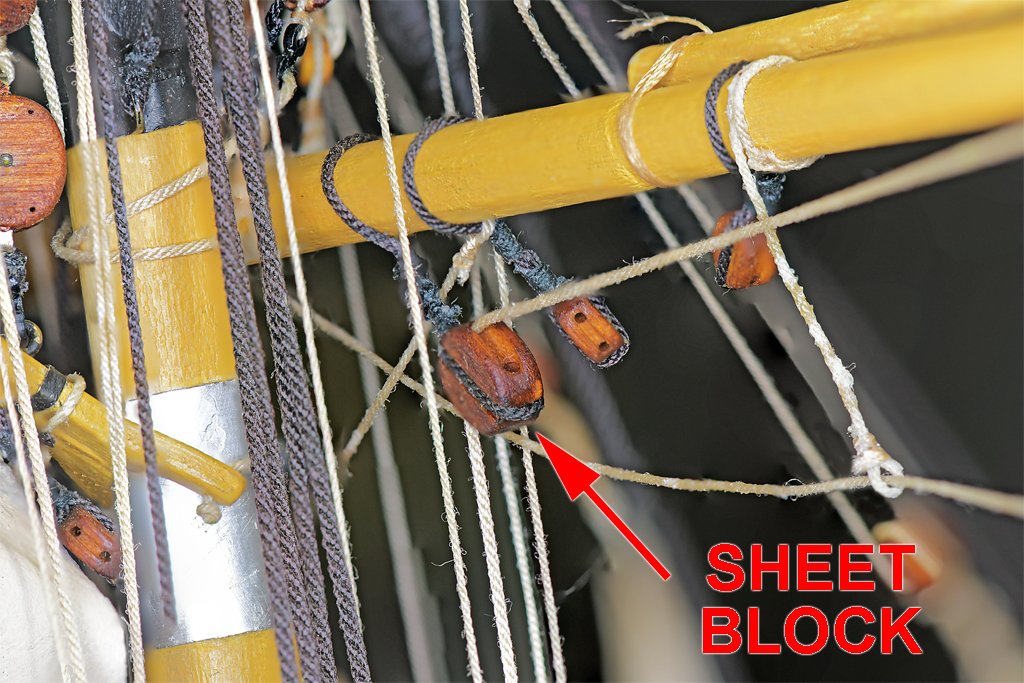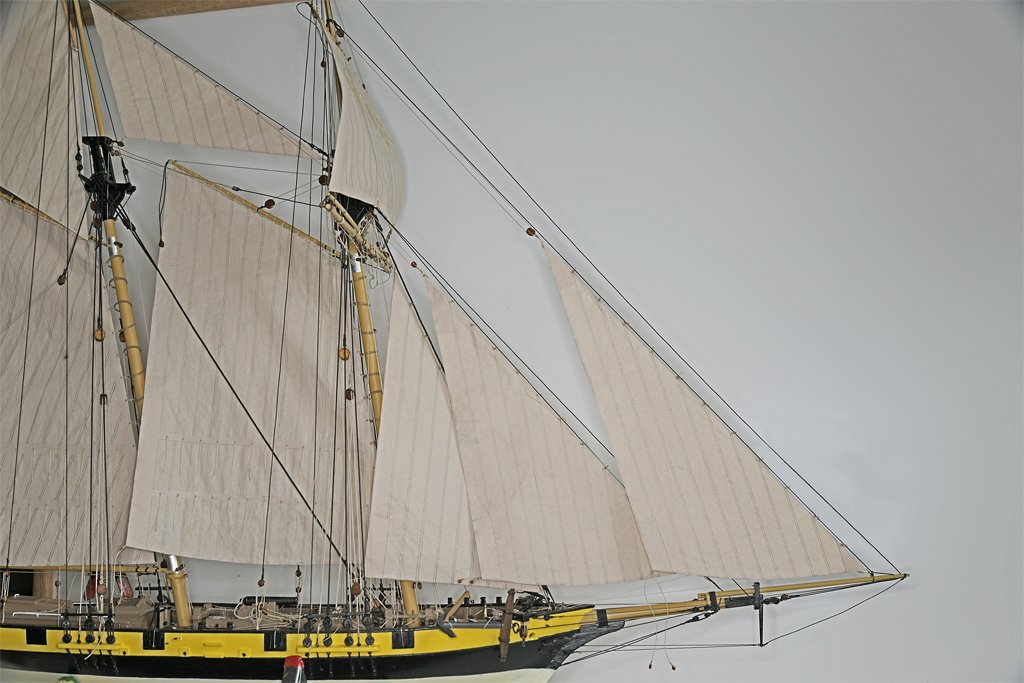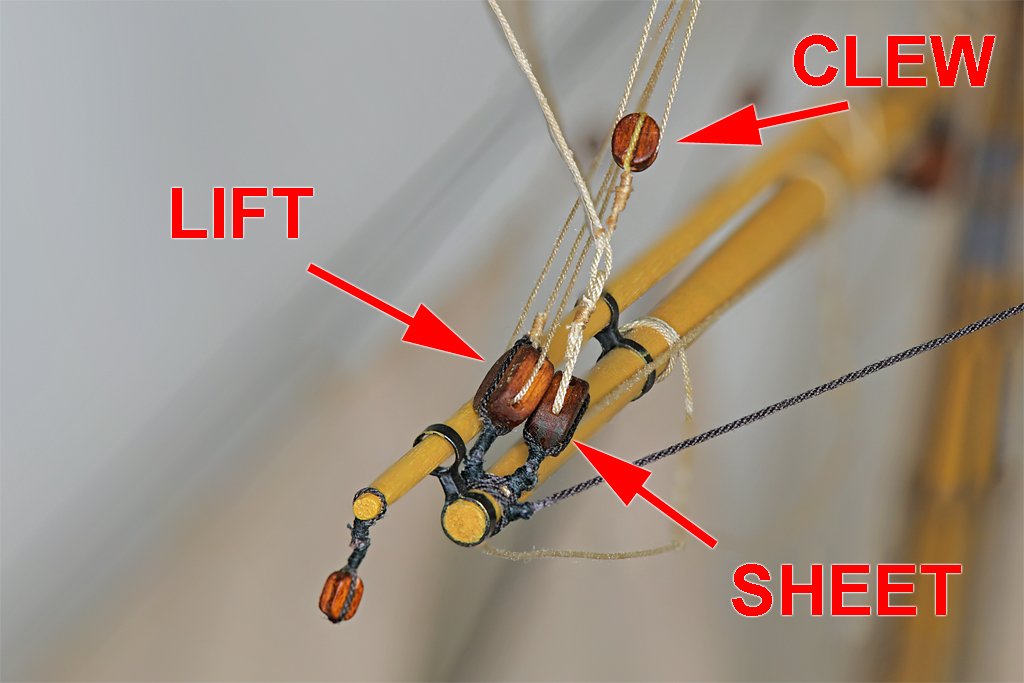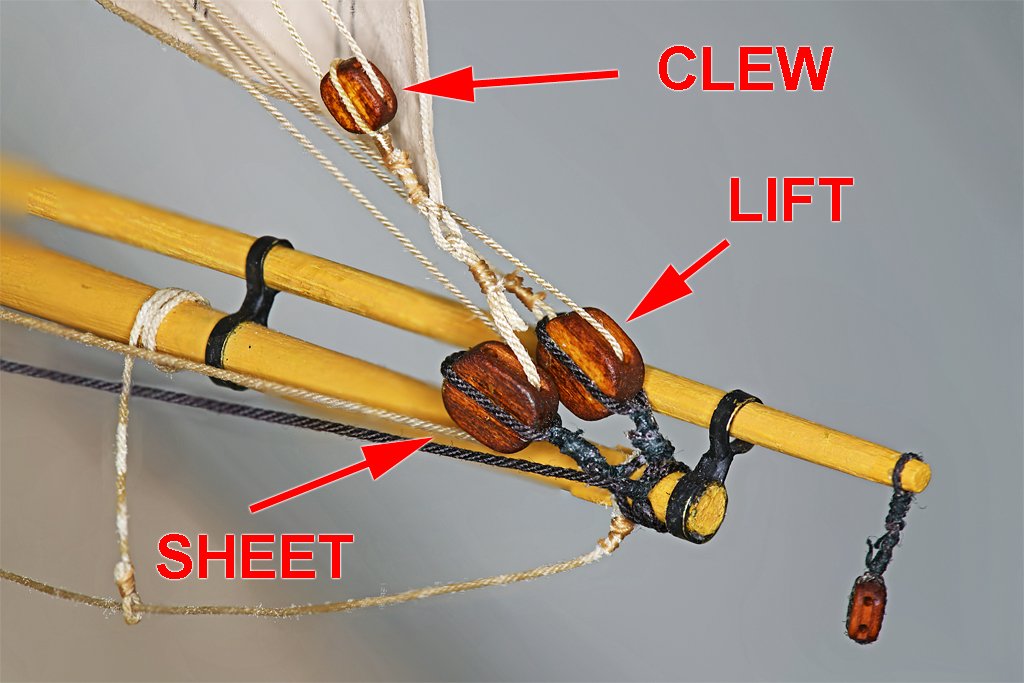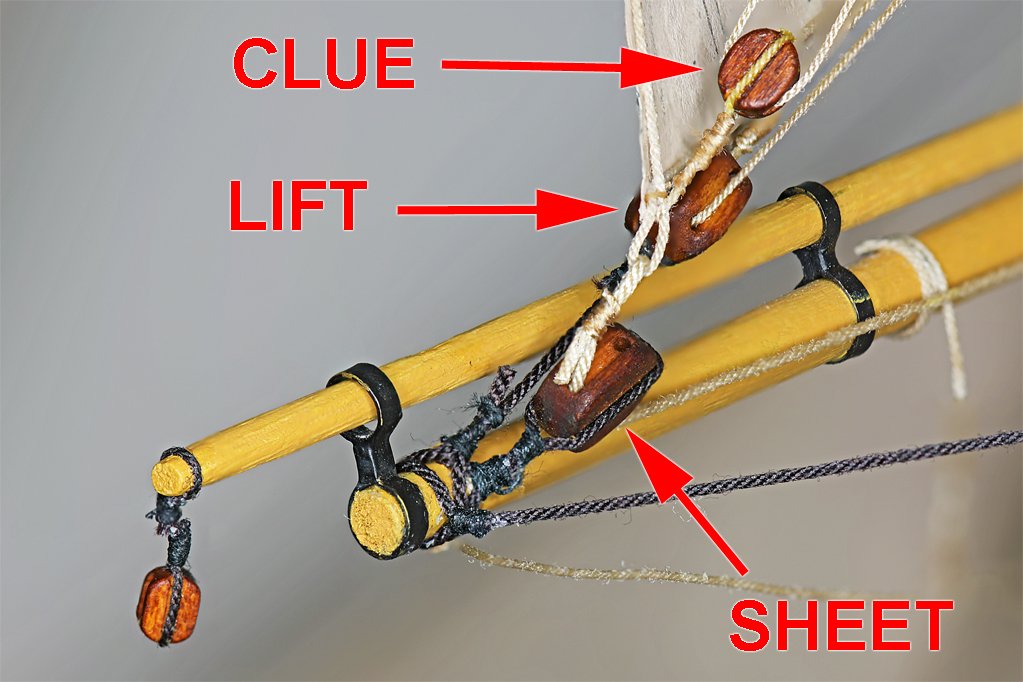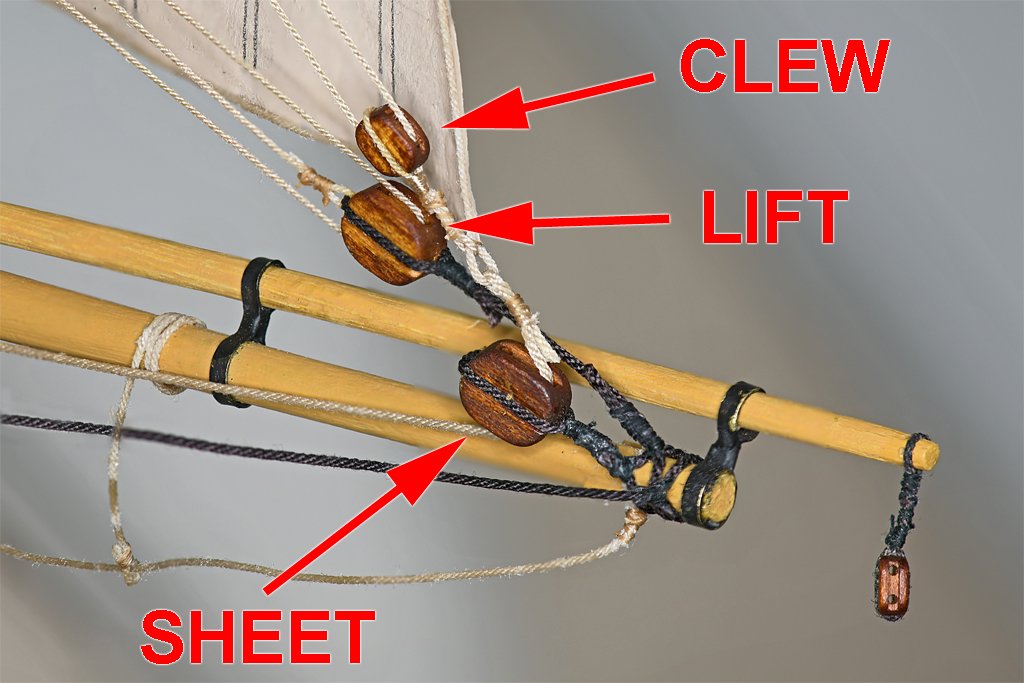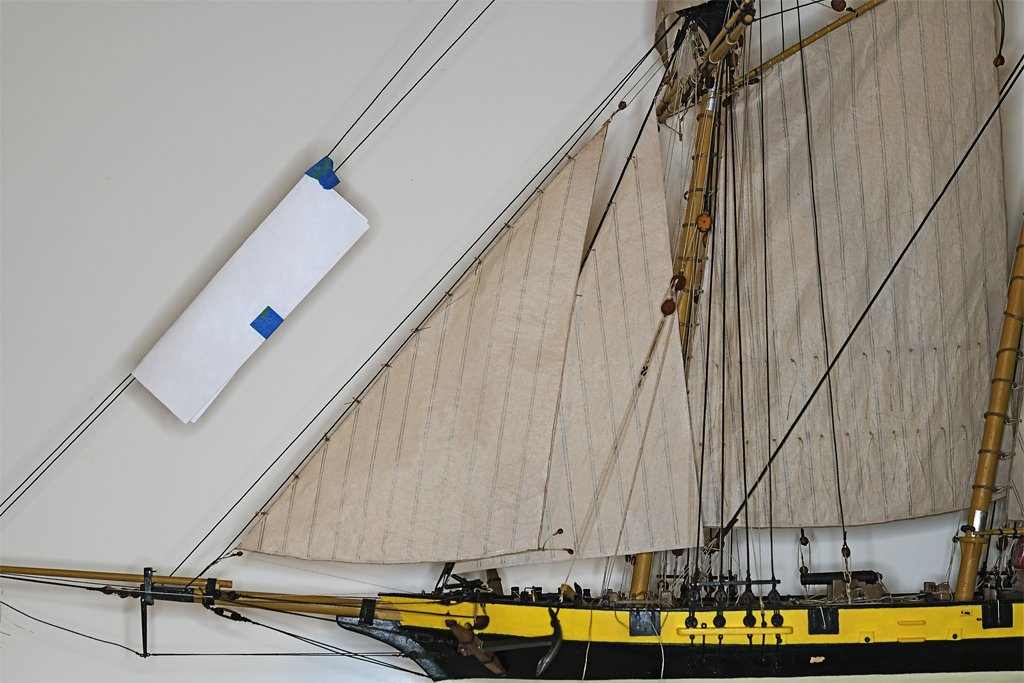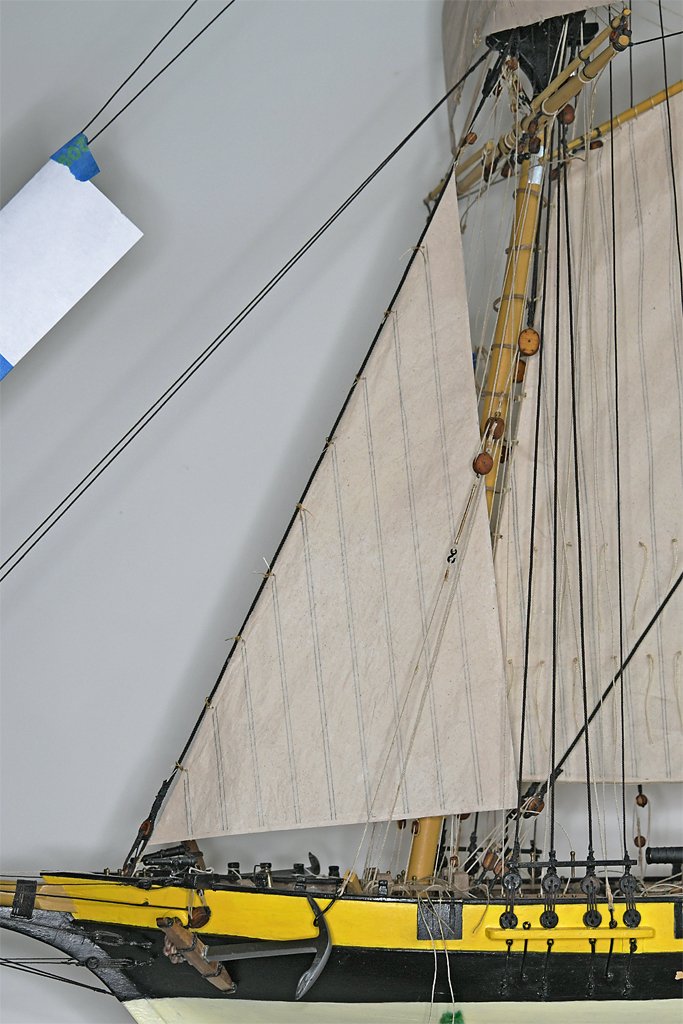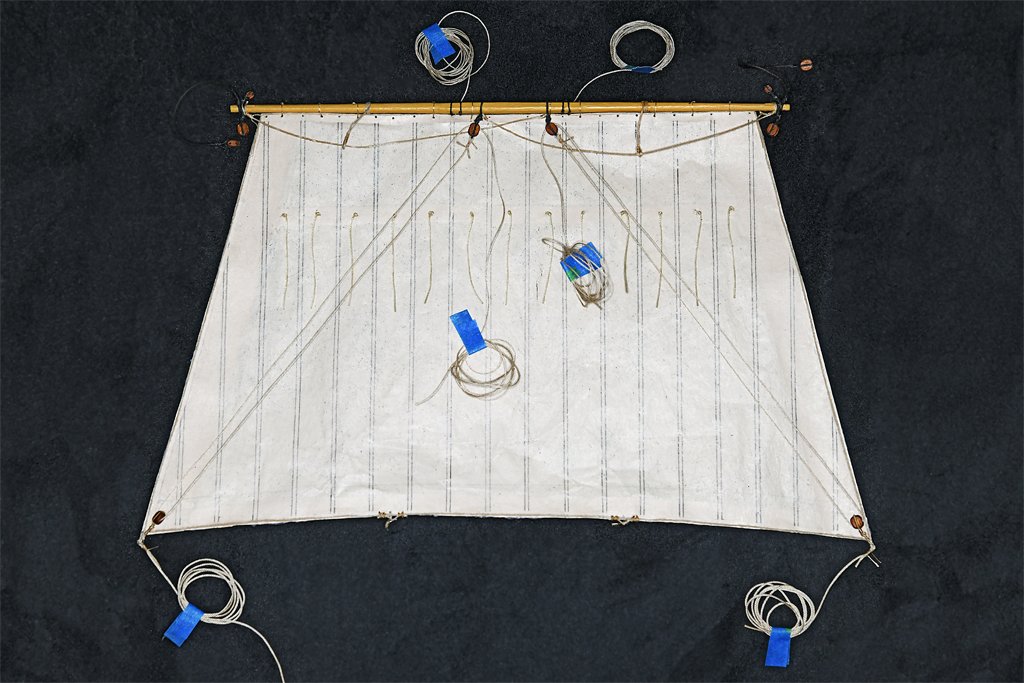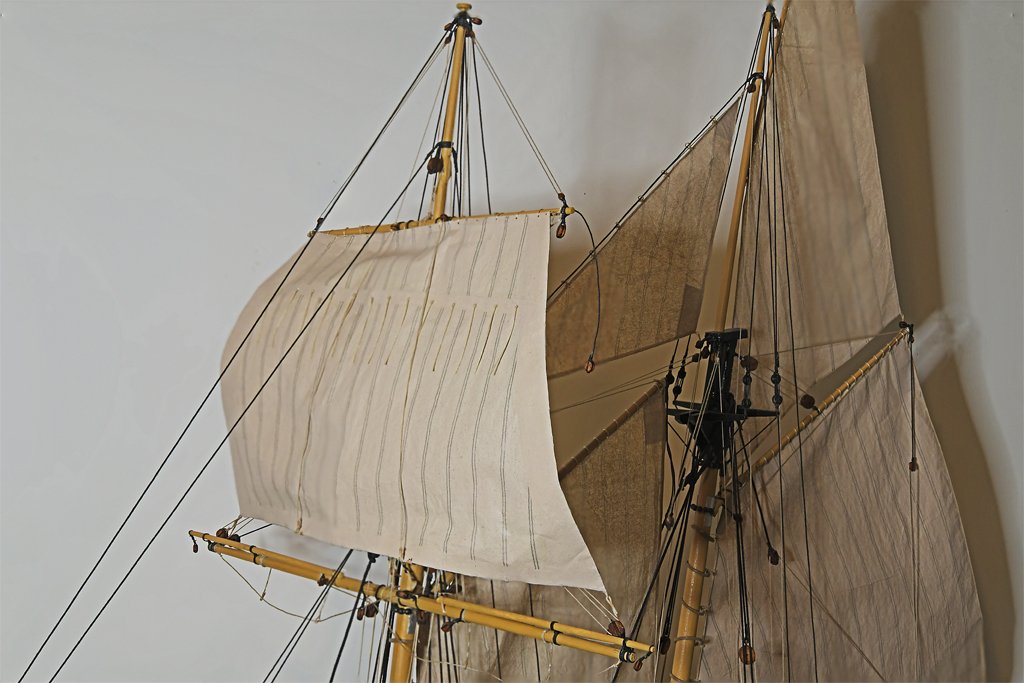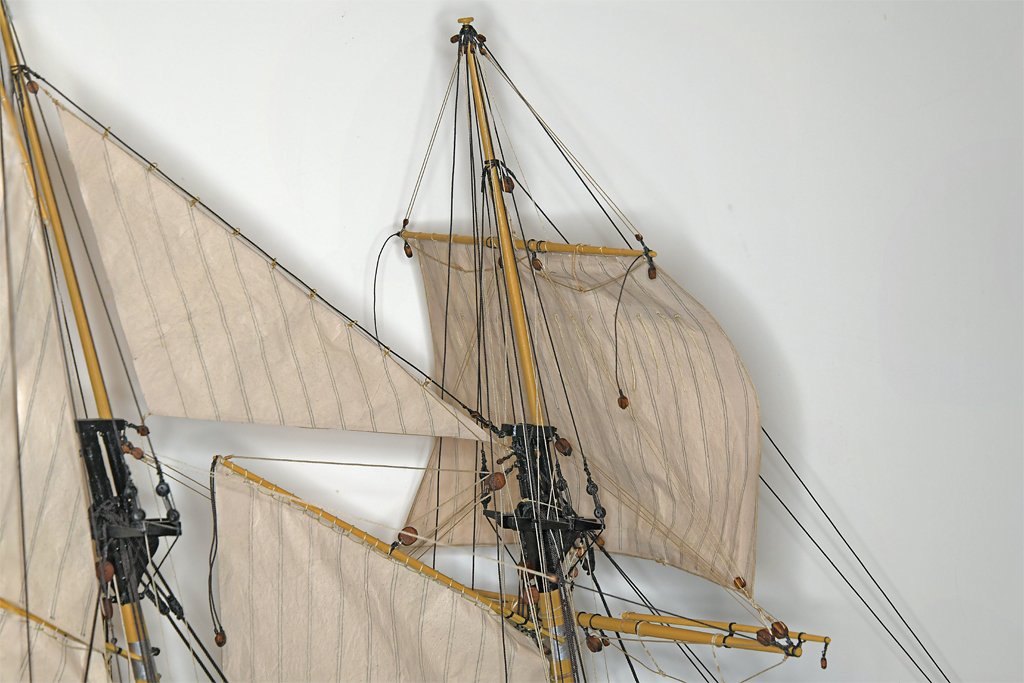-
Posts
2,450 -
Joined
-
Last visited
Content Type
Profiles
Forums
Gallery
Events
Everything posted by Dr PR
-
Falconer's Universal Dictionary of the Marine (1769) says the lanyards in deadeyes were smeared with hog's lard or tallow so it slips more easily through the holes. Consequently I would suspect that they aren't tarred heavily, But the fat probably oxidized to a brown color, so the lanyards wouldn't look like new rope - unless they were new. He doesn't say anything about rat lines (rattlings) being tarred or not. But they are part of the standing rigging. Since the shrouds were tarred it is safe to assume the ratlines would be tarred also.
-
It has been a while since I updated this log. I have been working to finish the rigging on my topsail schooner build, and that has been very time consuming. I had to order more rope for that job, and also ordered a helm (ship's steering wheel) for the Cape's pilot house. I considered carving one from scratch, but noticed that Syren had two "mini kits" for ship's wheels, 15/16 inch (26.34 mm) and 1 ¼ inch (31.75 mm) diameter. The kit wheels are ten spoke wheels, and the Cape's wheel had eight spokes. I originally estimated from the pilot house photo that the wheel was about 4 ½ feet diameter. So the 1 ¼ inch wheel would be closet. But I have since found a blueprint that says the wheel was 48 inches diameter – 1 inch at 1:48 scale. So this wheel is a bit oversized. But only the top will be visible in the model's pilot house, so this is good enough! If I had the proper tools I might try making a wheel, but the Syren kit is a lot simpler, and can be finished faster. So I decided to order the Syren kit and see how it works out. Here is a build log for the Syren 1 ¼ inch Ship's Wheel kit. The kit comes in a small plastic bag with seven small pieces of laser cut Castello Boxwood and a kit label. You must visit the Syren web site to get the instruction sheet PDF file. The instructions caution to not use CA (cyanoacrylate) glue for assembly. It sets too fast, and you need to be able to align parts before the glue hardens. Syren recommends water soluble yellow glue. I used Sig-Bond aliphatic resin. The instructions say to sand all sheets lightly to remove laser char. These are solid wood sheets, not plywood, and they have grain. If you bend the thin sheets along the grain they will break. Handle with care! The two largest sheets must be carefully aligned and glued together to create a jig for the wheel assembly. The ten round holes in the bottom sheet should line up in the center of ten arc holes in the top sheet. I used the shank of a 3/32 inch (0.094 inch, 2.4 mm) drill bit to align the center holes. Next you should remove the "rim segments" – the short arc pieces – and carefully sand or file the curved edges to remove char. The short end sides should not have the char removed so they will fit tightly in the assembly jig holes. The instructions suggest using 320 grit sandpaper and sanding lightly to remove char. I used a small "D" cross section file and used very light pressure. I used tweezers to hold all of the small pieces firmly while removing the char. Some of these parts are only 0.025 inch (0.6 mm) thick and fragile. By filing only where the tweezers hold them I avoided bending the parts. Even so, I did break off a bit of one of the "C" shaped pieces, but it glued back together nicely with Duco Cement. It didn't take long to remove the char from all the parts. Extra pieces are included for the rim segments and spokes in case you lose or break one. The next step was to place the rim segments into the positions in the jig. Here you see seven of these pieces in the holes in the jig, and three more waiting to be placed. They are not glued! I found it necessary to file the curved sides a bit to remove all of the char before the pieces would fit into the jig. The rim segments are thicker than the jig piece and stand proud. Next the ring "C" pieces were glued to the rim segments. You must use glue sparingly, placing a small drop on the rim segments to ensure that you don't glue anything to the jig. Clean up any glue that squeezes out. Here two ring pieces have been glued in place and the third is waiting. Position these carefully over the rim pieces so a bit of the rim segments shows on both sides. I used Sig-Bond aliphatic resin to glue the parts together. It is slow setting and that allowed me to center the ring pieces on the rim segments. I allowed the glue to set several hours before working with these pieces. Next the wheel hub was made by gluing a "star piece" to a circular disc. I used the 3/32 inch drill bit as a mandrel to ensure that the pieces were centered correctly. After the glue set I scraped the char from the star piece. I probably should have done this before gluing the pieces together. Any glue that squeezed out was removed. After the glue had set the wheel rim was removed from the jig. To do this I pushed through the holes from the back of the jig, one at a time gently until the ring was free. The wheel spokes will fit into the gaps between the rim pieces. The "C" pieces are very thin and will break if you put too much force in any one position. Work slowly and work the piece free a bit at a time. After it is free from the jig you can sand both sides of the ring to make them smooth. The wheel spokes have square cross sections when removed from the sprue. The instructions say to remove the char from the square parts that fit into the ring and the hub, but leave the char on the parts that need to be rounded. This makes it easier to see the places that need to be rounded, and those that should remain square. I used a motor tool to spin the spokes and the D cross section file to turn the parts between the ring and hub. The handles on the ends of the spokes were also fashioned with the file. The instructions say to turn all fourteen of the spokes provided with the kit before trying to place any on the ring and hub. You will get better at it as you go, and afterward you can select the ten best spokes to use in your ship's wheel. You can see where the file slipped on the bottom spoke and rounded the edges of the square segment close to the handle. Another spoke has a handle that is too large. Next the spokes must be trimmed to length. The jig has a pattern that can be used to trim off the extra material. The ends that fit into the notches in the star piece of the hub need to be filed to a "\_/" blunt point shape to fit All of the pieces need to be the right length so the square cross section pieces fit between the ring and the hub. This was the most difficult part of the build. I used the drill bit to center the hub on the jig. The holes in the jig were used to align the ring centered on the hub. Double sided tape held the ring in place while each spoke was trimmed to the same length. The spoke on the right is trimmed so the square section at the ring aligns on the inside with the edge of the ring. The piece on the left is a bit too long, so the inner part of the square section is too far out from the hub. I filed some off of the hub end until it was the correct length. With all the spokes the correct length it was time to glue them to the hub and the ring. Again, it was necessary to be careful that the ring, hub and spokes were not glued to the jig. For this job I used Duco Cement. It makes a good bond between wood pieces and takes a bit longer than CA to set so the pieces can be repositioned as necessary. After the glue set the surface was sanded smooth. Next the remaining "C" pieces were glued to the ring. I used Sig-Bond glue for this. The "C" pieces must be positioned carefully to be centered on the rim pieces. After the glue set the wheel was carefully lifted from the double sided tape. Then both sides were sanded with 150 grit paper to reduce the thickness of the "C pieces to about 0.012 inch (0.3 mm). Then they were finished with 220 grit sandpaper. The resulting wheel looks pretty good! I put a layer of shellac on it, and may follow up with more to darken it a bit. There are a few places when some of the char is still visible, and this probably should be filed off. If I had a lathe I might have turned some knurls or rings on the spokes like on the Cape's wheel. But I wasn't going to attempt this using a motor tool and a file! The original wheel had some brass parts around the hub. I am not going to try this at 1:48 scale. Now I just need a pilot house to put it in!
- 472 replies
-
- minesweeper
- Cape
-
(and 1 more)
Tagged with:
-
Paul, You are planking the hull from the inside out! That is a very good way to get all the bulwark frames in place. I envy you on this build. The HAER report drawings show so much detail of the construction of the ship. We don't have that detailed information for most builds. Somewhere here I should have photos (slides) I took on the Wapama back in 1972 when I was in San Francisco for discharge from the Navy. If I find them I'll scan them and send them to you.
-

Question re: Rigging Multiple Blocks at One Location
Dr PR replied to GGibson's topic in Masting, rigging and sails
Greg, Here is a bit of terminology. The yard is the spar the sail hangs from. The tapered end where all these lines and block go is the yard arm. Ya gotta know this stuff if you want to talk like a pirate! -
One less plastic hook on the model. The crash also broke the hook on the top block of the main gaff peak halliard luff tackle! One step back. I am repairing it using one of my metal hooks. Another step forward. Look at it this way - all those broken hooks and failed seizing just lets me have the pleasure of doing the rigging again! Thank you Murphy!
-

Question re: Rigging Multiple Blocks at One Location
Dr PR replied to GGibson's topic in Masting, rigging and sails
Take a look at this post: https://modelshipworld.com/topic/19611-albatros-by-dr-pr-mantua-scale-148-revenue-cutter-kitbash-about-1815/?do=findComment&comment=1092641 I rigged the blocks at the yard arm pretty much as shown in your drawing and had to go back and redo one of them to allow the lines to run free without tangling and chafing. Each block should be attached to the yard arm separately. I used seizing (small thread wrapped tightly around the ropes) that was glued to the ropes. The outer black rope is the brace pendant with a block stropped (strapped) and seized into the end. This is the lower block in your drawing. It prevents the other ropes/blocks from slipping off the yard arm. But on my vessel the stunsail boom irons hold everything on the yard arms. -
Steve, There are still too many plastic hooks on this model! But take note that they are not failing during the normal rigging process. I don't put a lot of strain on the lines, just enough to make them run pretty straight. The hooks are breaking when I screw up and accidentally put too much stress on the lines. Murphy again! I repaired the sheet block. I wrapped some 0.025" (0.63 mm) rope around the block for stropping and glued it in place around the block with white glue. Then I put a drop of Duco Cement on the two strands and wound some fine black cotton thread around it to create the seizing. After that was set I looped the long end of the 0.025" rope around the fore course yard inside the sling cleats (in the photo at left). I tied a piece of black thread around the rope strands with an overhand knot. Then I put a drop of Duco Cement on the two rope strands and held them together a few seconds until the glue started to set. Then the long end of the thread was wrapped around the ropes to finish the seizing. It was a tight fit! One point in Duco Cement's favor - over CA - is that like the white glue you can loosen the knots easily, but with a bit of acetone instead of water. The sheet rope had a small block seized to the lower end as part of a runner tackle. Since I couldn't pull this through the sheet block the sheet rope was pulled back and held out of the way with blue tape while I made the repair. Then I discovered that the sheet rope was wrapped around the footropes on the yard and one of the other ropes descending from above! I had to remove the lower block from the end of the sheet rope and reroute the line through and around the rats nest of ropes around the mast top. Of course, I had glued the lower block strop seizing with Duco Cement, and it didn't want to come undone. But the strop was glued with white glue where it passed around the block. A little water on the strop to loosen the white glue and I was able to pull the block free. Then I had to soak the seizing in acetone to dissolve the Duco Cement. After a while the seizing came off and the rope end was free. I didn't want to wet the block with acetone because the dye that I used to stain the block might wash out. After rerouting the sheet rope the lower block was attached again - with Duco Cement to ensure that the seizing doesn't fail. This photo shows the repaired block, with the sheet rope threaded through and around the other lines so it descends to the runner tackle belayed to an eye bolt on deck and a pin on the fife rail at the base of the mast. In the process the course yard creeped up on the mast again. It should be just at the top of the metal shield for the gaff jaws. Now I will need to readjust all of the lifts, sheets, buntlines, trusses and braces to get it back down again! Maybe Murphy's Folly would be a good name for the ship.
-
Thanks for the encouragement guys! The irony in this last goof-up is that I was trying to get a better picture of the outer jib. I was using a white dry erase marker board as background and the shiny surface was reflecting the ring light. So I repositioned the board, and as I stepped back to take the picture the board fell over against the model. Fortunately I was still close enough to catch things before the model took a dive to the floor! Otherwise I might be thinking about reconstructing a lot more of the masts and rigging! So Murphy didn't have the last say! And I relearned a lesson that I have learned far too many times in the past - pay attention to what you are doing! **** The model kit was titled "Albatross" but I can find no record of a real vessel with that name. And since I am building a model of an imaginary 100 ton revenue cutter of the early 1800s I have been reluctant to give the model a name. That might imply that it is a model of a real vessel. But now I am thinking of calling it Murphy's Jest or something like that! Murphy's Joke Murphy Bait Murphy's Taunt Murphy's Fun ????
-
I have been thinking abut a problem that developed as I was adding the fore topsail to the mast. You can see it in these pictures. The lift blocks and sheet blocks were jammed together, and the lift lines were rubbing against the sail clews and the clew blocks. It looked OK "on paper" but just wasn't right after the sail was installed. The sheet block was in the correct place, with the sail clew and clew line block OK. I decided to remove the lift blocks and give them a longer pendant. But I had to do this in place, and things were a bit crowded. Some vessels used a sister block or "violin block" with the lift running through the inner sheave and the sheet in the outer sheave. And in some cases the two blocks were just stropped together end to end to keep the two lines separate. Now the lift blocks fit under the clew of the sail and the sheet is free to run naturally. It wasn't as much trouble as I thought it would be. But Murphy did get in his licks. While removing the old lift blocks the plastic hook on one of the double blocks at the mast top broke! I replaced the plastic hook with one of my metal hooks and the repair was finished. One step back, one step forward. All of this happened while I was installing the outer jib. That was the last sail! Like the other fore sails the sheets are still hanging loose. But the rest of the rigging is in place! Two steps forward. The nomenclature for this sail is a bit confused. Some authors call it the outer jib, but others call it the flying jib. However, the term "flying" sometimes means a sail is not attached to a stay, but is hanging only by the halliard and tack. But there are many references showing a sail that is riding on a stay but is called a flying jib anyway. Likewise the main sail is sometimes said to be flying if there is no boom, and in other books is is flying it it is attached to the boom only at the tack and clew, without being laced to the boom. This is also called "loose footed." So the term "flying" seems to mean different things to different authors. With the installation of the outer jib almost all of the rigging is installed. Most of the lines are belayed and only a few need to be adjusted. The belayed ends are still a couple inches long to allow them to be adjusted, so the deck looks like a bowl of spaghetti. But most of the work was done! And then the backdrop I was using for this last photo fell over and hit the model! The blow caused the seizing to fail on the starboard sheet block attached near the center of the fore course yard! It was in one of the most inaccessible places in the rats nest of rigging just under the fore top. One giant leap backwards! Murphy was busy today!! If there are any newbies following this log keep this in mind. If it can go wrong it will go wrong!
-
Actually, the trick is to cut the garboard strake so the next plank runs pretty straight to the stem (bow). The lower edge of the garboard strake follows the rabbet at the keel. curving up at the bow. The upper edge of the garboard strake should follow the unmodified edge of the next plank as it curves around the bow. Each additional plank follows the same rule. The lower edge follows the curve of the plank below it, and the upper edge is trimmed to follow the curve of the plank above it. So one edge of each plank is the natural curve around the shape of the hull, and the upper edge is trimmed to fit the plank above it. While this sounds simple, it may be necessary to "hook" planks above and below a plank, cutting it short and hooking the planks above and/or below to fill in the space. Look at the tutorials.
-
I found time today to install another sail - the jib. The jib halliard is rigged like the fore staysail halliard - through a block that is tied to the forward crosstree on the fore mast top. The tack is fastened to the jib preventer stay just above the bees on the bowsprit. The downhaul runner block is also belayed to the preventer. The downhaul runs through this block and belays on the starboard bow pin rail. The sheets have not been rigged so the sail can be pulled forward to provide clearance to the bow pin rails. Only one sail to go!
-
One more! The fore staysail is pretty simple. Lever (The Young Sea Officers Sheet Anchor, page 59) said that fore staysails were not used on merchant vessels, but were only used on warships. This likely applies only to square rigged vessels, for multiple foresheets are common on fore-and-aft rigged vessels. But you can see from this photo why the fore staysail and the main course would not be flown at the same time. The clue of the staysail extends back behind the fore mast, passing through the space where the fore course sail would hang. Schooner sails were mainly fore-and-aft with the occasional square topsail, topgallant and maybe a fore course. So the fore staysail was probably used in most cases, with the course rigged only when there was a good wind from astern. I had to find a place for the halliard block pendant to attach to the mast top. Rather than tie it to the stay as is sometimes done I lashed it to the front crosstree, similar to how the main boom topping lift pendants are attached to the aft crosstree on the main mast top. I attached the fore staysail and jib block pendants to the crosstree before attaching the topsail. The topsail hangs down over these blocks, making it a bit harder to rig the sails. In hindsight it would have been a bit easier to rig the fore staysail and jib before adding the topsail! The staysail tack is lashed to the port side of the bridle for the lower forestay open heart. The staysail downhaul block is lashed to the starboard side of the heart bridle. The downhaul is belayed to a pin on the starboard bow pin rail. I have tied all of the hanks to the sail, but the glue is still drying so I haven't trimmed the loose ends of the lines. The sheets are not rigged yet. The sail interferes with getting to belaying points on the fife rail at the base of the fore mast. With the sheets loose I can pull the sail back forward to open access to the fife rail. I have learned that good access to the fife rail is important. Each of the many lines to points on the fore mast interacts with all the others. I did haul the topsail yard back to its highest position, and this put some lift on the fore course yard. That in turn loosened the fore course yard truss lines and the fore course yard lifts. So those lines had to be tightened. Again, it was wise to use white glue to secure lines after they have been belayed. Adding a drop of water loosened the glue so I could pull the belayed truss and lift lines tight again. And I had to adjust the fore topsail buntlines after raising the topsail yard. I would be willing to bet this won't be the last time I need to adjust lines before the model is finished!
-
There are reviews on the Forum of the shroud jigs - mostly negative.
- 62 replies
-
- prince de neufchatel
- model shipways
-
(and 1 more)
Tagged with:
-

Buying Filler Blocks
Dr PR replied to mikiek's topic in Building, Framing, Planking and plating a ships hull and deck
Balsa would be easier to cut and shape. The filler blocks do not need to be strong. They just provide a shaped surface between bulkheads to glue the planks to. You don't need to fill the entire space between bulkheads. All you need is something out at the hull surface. Some people just use pieces of wood dowel, with multiple pieces cut to fit horizontally between bulkheads along the outer edges. Whatever you use should extend out beyond the bulkhead edges a bit so you can sand them down to fair a curved surface between the bulkheads. -
Had the same problem with my Albatross kit. The supplied guns and carriages only fit under the cap rail if the guns were pointed down. Good for fishing maybe, but worthless for combat. I scratch built a new set of carriages that were lower and allowed the guns to run out horizontal, and then have a 5 degree rise.
-
I have been using a mini iron to heat form planks directly on the hull and it works better than anything else I have tried. I clamp the plank in place in a few places, wet it with a brush, and apply the heat. This gives the planks the correct curvature and twist for fit the shape of the hull, and it only takes a couple of minutes. https://modelshipworld.com/topic/37060-uss-cape-msi-2-by-dr-pr-148-inshore-minesweeper/?do=findComment&comment=1074225 https://modelshipworld.com/topic/37060-uss-cape-msi-2-by-dr-pr-148-inshore-minesweeper/?do=findComment&comment=1075263
- 47 replies
-
- La Nina
- Artesania Latina
-
(and 1 more)
Tagged with:
-
The ratlines look good. I deliberately saved the ratlines for last because much of the rigging belays on the pin rails and fife rails and the ratlines would block access.
- 62 replies
-
- prince de neufchatel
- model shipways
-
(and 1 more)
Tagged with:
-
More progress, sort of ... Two steps forward and one step back. The fore topsail has sheets, clew lines and buntlines attached, along with the blocks for the clew tackle. This is the aft side where the bolt ropes are attached. Here is the sail installed on the fore mast. The bunt lines attach to cringles on the foot of the sail. They run up the forward side of the sail through wooden thimbles lashed to the topsail yard and up through single blocks attached to the top of the fore topmast. They lead down through fairleads on the mast top crosstrees and then belay to the fife rail at the bottom of the mast. Another picture from the rear. Things are getting crowded around the fore masthead! The topsail yard halliard, clue lines, topsail yard lifts and fore course yard lifts also run through the crosstree fairleads and down to belay at the fife rail or the bulkhead pin rails. So far the lines are running clear with no chafing. I may not need to reroute any of them! While rigging all of these lines the halliard slipped a bit, lowering the topsail yard - probably while I was rigging the buntlines. I didn't intend for the sail to billow out as if there was a strong following wind! Fortunately all of the lines are belayed with just one turn around the belaying pin, and held in place by water soluble white glue. So it is pretty easy to place a drop of water on the glued area and readjust the length of the lines. Pretty obvious are the dangling topsail yard brace pendants and locks. I have discovered that I didn't order enough of the 0.012 inch (0.30 mm) tan rope from Syren. But I did order one extra dark brown 0.012" package! I made the order calculations with my rigging spreadsheet, and I may have mixed the tan and brown ropes when selecting rope length cells. Or maybe I just used more rope than I calculated - I need about four feet more! I have ordered more. Work doesn't have to stop though. I have all the rope I need to finish the foresheets. The topsail yard braces will be some of the last lines to belay. I don't look forward to that! They belay on the rail at the base of the main mast, and that is one of the most inaccessible places on the model! It took me one hour each to rig the main topmast staysail halliard and sheet on that rail! The topsail yard braces belay inboard of those two lines. I'll have to devise some tool to improve my chances of rigging these lines!
-

SMS Karlsruhe by Wreck1919 - 1/100
Dr PR replied to Wreck1919's topic in - Build logs for subjects built 1901 - Present Day
Beautiful model! -
Very nice model! I started my current topsail schooner build almost 40 years ago, and am finally getting close to the finish! Like you marriage, family, house and work really interfered with my ship modeling! I am looking forward to your finished model - however long it takes.
- 62 replies
-
- prince de neufchatel
- model shipways
-
(and 1 more)
Tagged with:
-
Some things are simple. For example, the forward bulwark stanchions were attached to the planksheer with metal "L" brackets with trapezoidal sides. There are a lot of these and photo etch would ensure uniformity. I may also get a lot of metal hooks in various sizes. The pilot house window shades and their supports could be made with photo etch or by hand out of thin brass. Ditto venturis. If here is room on a sheet I will add these. The scuttles and hatch comings had metal flanges. Antenna foundations, searchlight support flanges, smoke stack exterior and bulkhead plates. It would be easier and more uniform to make these by photoetch. But probably the largest number of pieces will be from all the minesweeping gear on the aft part of the main deck. There are some pretty elaborate frames, decks and cable reels. I haven't modeled these in CAD yet so I don't know the total number of parts. I will build as much as I can from K&S brass parts - if I can get them.
-
Paul, Thanks. I hadn't heard of fuzzy thread. I'll have to look around at Joann's to see what it looks like. As far as the nomenclature goes, here are some references. Chapelle's The American Fishing Schooner (page 401) said chafing matts were wrapped around schooner topping lifts - what I am interested in. He said "Chafing gear was of rope yarns, made up into 'baggy winkle' and wrapped around the lifts or jacks ..." Falconer's Universal Dictionary of the Marine (1769) said "Mat ... a sort of thick web or texture, formed of spun-yarn, or a variety of strands, or separate parts of small rope, or a number of rope-yarns twisted into foxes. The foxes are therefore larger or smaller, containing a greater or lesser number of rope-yarns, in proportion to the thickness of the mat intended to be woven. Mats are commonly used to fasten upon the outside of such parts of the standing rigging as are exposed to friction of other ropes ... The largest and strongest sort of these mats are called panches." Bjorn Landstrom's Sailing Ships (page 179) says "To protect the [schooner] mainsail from wear the boom lifts have been given baggywrinkles." Underhill's Sailing Ship Rigs and Rigging (pages 108 and 112) says "chafing gear" is also called "puddening." "... old rope, canvas, oakum, rope-yarns, etc., made up to required shape an fixed on stays, rails, etc., to prevent chafing the sails." Lever's The Young Sea Officer's Sheet Anchor (page 68) says the rope/yarn wrapped around the anchor ring is called puddening. Nothing else that I could find about protecting sails from chafing. "Service" is commonly used to describe line wrapped around ropes, or "serving" the line. However I have seen a reference (which I can't find right now) saying that anything wrapped around ropes to prevent chafing is called "service." Most of the references I searched through don't say anything about chafing gear, mats, baggy winkles/baggywrinkles, panches, puddening, service or such. So take your pick!
- 15 replies
-
- baggy winkle
- service
-
(and 2 more)
Tagged with:
-
My brother-in-law was "driving" Voyager 2. He calculated the orbits and the engine and thruster commands to get the craft to Saturn, Uranus and Neptune. Really cool stuff, even if the paint did dry sssslllloooowwwllllyyyyy!
- 472 replies
-
- minesweeper
- Cape
-
(and 1 more)
Tagged with:
About us
Modelshipworld - Advancing Ship Modeling through Research
SSL Secured
Your security is important for us so this Website is SSL-Secured
NRG Mailing Address
Nautical Research Guild
237 South Lincoln Street
Westmont IL, 60559-1917
Model Ship World ® and the MSW logo are Registered Trademarks, and belong to the Nautical Research Guild (United States Patent and Trademark Office: No. 6,929,264 & No. 6,929,274, registered Dec. 20, 2022)
Helpful Links
About the NRG
If you enjoy building ship models that are historically accurate as well as beautiful, then The Nautical Research Guild (NRG) is just right for you.
The Guild is a non-profit educational organization whose mission is to “Advance Ship Modeling Through Research”. We provide support to our members in their efforts to raise the quality of their model ships.
The Nautical Research Guild has published our world-renowned quarterly magazine, The Nautical Research Journal, since 1955. The pages of the Journal are full of articles by accomplished ship modelers who show you how they create those exquisite details on their models, and by maritime historians who show you the correct details to build. The Journal is available in both print and digital editions. Go to the NRG web site (www.thenrg.org) to download a complimentary digital copy of the Journal. The NRG also publishes plan sets, books and compilations of back issues of the Journal and the former Ships in Scale and Model Ship Builder magazines.



